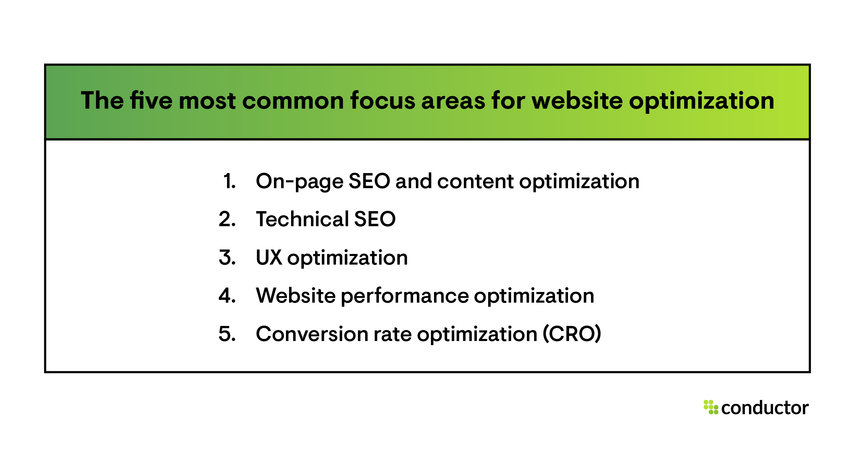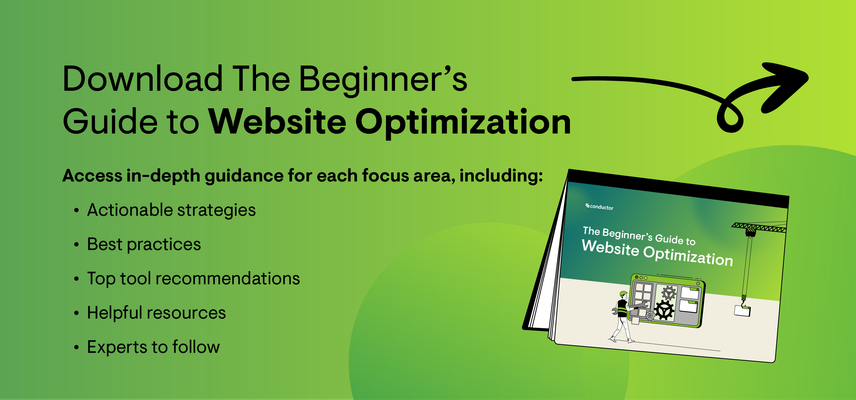The Beginner’s Guide to Website Optimization
Website optimization is an ongoing, cross-functional effort requiring collaboration across multiple digital teams.
By systematically addressing issues and implementing proven strategies in each of the 5 core focus areas, you can improve discoverability, UX, and conversion rates to drive more traffic, engagement, and revenue.
Small, continuous improvements can make a big impact, so don't be afraid to experiment, iterate, and continuously refine your approach.
Your website is your most valuable conversionConversion
Conversions are processes in online marketing that lead to a defined conclusion.
Learn more generator and the only element of your business working around the clock. But if it’s not optimized to provide the best user experienceUser Experience
User experience (or UX for short) is a term used to describe the experience a user has with a product.
Learn more (UX) and rank well on search engineSearch Engine
A search engine is a website through which users can search internet content.
Learn more result pages (SERPs), users won’t want to use it—and likely won’t be able to find it.
The right website optimization strategies resolve these issues to transform your website into a growth engine that propels users to click, convert, and keep coming back for more.
In this beginner’s guide, we’ll cover the basics of website optimization and delve into each of the five core focus areas within it.
What is website optimization?
Website optimization is the process of improving website performance across core areas—including speed, usability, conversion rates, SEO, and content—to increase traffic, engagement, conversions, and revenue.
The large scope of website optimization requires cross-functional collaboration from web, content, SEO, digital product, and design teams to ensure it’s done right.
The best way to think about it is as a continuous process rather than a one-and-done effort. We’ve found the most effective approach to optimizing a website is to break it down into core focus areas for easier implementation and accountability.
SEO vs. website optimization: What’s the difference?
An important clarification between SEO and website optimization is that SEO is a strategic approach that falls under the umbrella of website optimization. SEO focuses specifically on improving a website’s discoverability and visibility in SERPs by making on-page changes and improving the website’s popularity by gaining links to it, aiming to improve search rankingsRankings
Rankings in SEO refers to a website’s position in the search engine results page.
Learn more for key search terms.
Enterprise brands recognize the importance of SEO and tend to prioritize it accordingly. However, these efforts are more effective when implemented as a holistic website optimization strategy that expands beyond technical or on-page SEO to incorporate UX enhancement, conversion rate optimization, and more.
After all, how helpful is an increase in organic search traffic if users bounce due to a poor UX or fail to convert because CTAs aren’t compelling enough? The goal of website optimization is to make strategic improvements to attract more visitors from various channels and ensure the highest likelihood of those visitors converting.
Why is website optimization important?
Reaching and engaging your target audience is more challenging today than ever before. SERPs are saturated with an influx of auto-generated content, and emerging disruptions like Google’s Search Generative Experience threaten to take up valuable SERP real estate and decrease organic CTR. Search and social media algorithms change regularly, and new social platforms appear overnight, requiring new channel-specific marketing strategies. Users quickly abandon websites with slow loading speeds, confusing navigation, or poor experiences.
Optimizing your website effectively and maintaining it can help you overcome these challenges and do more with the users you reach. Not to get hyperbolic, but effective website optimization really can transform your website into a growth engine. Here are a few tangible website optimization benefits:
- Improve website performance (AKA speed). Speed is everything when it comes to providing the best UX possible. Today, users and search engines demand it. Focusing on improving speed and resolving things like latency issues helps reduce bounce rates and increase visibility on SERPs, as page speed is a core ranking factorRanking Factor
The term “Ranking Factors” describes the criteria applied by search engines when evaluating web pages in order to compile the rankings of their search results. Ranking factors can relate to a website’s content, technical implementation, user signals, backlink profile or any other features the search engine considers relevant. Understanding ranking factors is a prerequisite for effective search engine optimization.
Learn more. Increased speed also drives more leads and revenue generation, as users are more likely to convert on a fast-loading site. - Increase website traffic. Along with improving website speed, optimizing your website’s content, on-page SEO, and technical SEO makes it easier for people to find your website via search engines, which leads to increased organic traffic.
- Increase revenue. By implementing conversion rate optimization (CRO), you can turn that increased website traffic into more conversions, which leads to more revenue.
- Improve brand visibility and awareness. The more often you appear on SERPs and social media news feeds and drive clicks to your website, the more opportunities you have to showcase your brand and deliver personalized experiences that potential customers remember when it comes time to purchase.
- Accessibility and legal compliance. Another significant benefit is the reduced risk provided by accessibility and legal compliance. If you’re running regular audits or monitoring your website as a part of your optimization efforts, you can take action to resolve legal or accessibility issues ASAP before you get hit with hefty fines .
- Cost-effective. Optimizing a website future-proofs efforts and can be a more cost-effective strategy to increase short- and long-term ROI vs. relying on paid campaigns.
The 5 core focus areas of website optimization
Optimizing a website can seem daunting when you consider everything it entails. Set your efforts up for success by categorizing needs based on the core focus area they fall under. This will make it easier to divide responsibilities between content, SEO, digital product, eCommerce, and web teams when it comes time to implement. Get started by auditing your website to identify the improvements, investments, and resources needed for each focus area.

Here’s a look at what each of these optimization focus areas entails.
On-page SEO and content optimization
Content optimization speaks to the process of planning, producing, and distributing value-driven, SEO-friendly content that educates users about your products while conveying your expertise and building trust.
On-page SEO is the practice of optimizing everything on the site for search engines and users. Technically (pun intended), technical SEO is also a component of on-page SEO, but given its importance and for the sake of clarity and easier implementation, we’ve decided to split them into different optimization focus areas.
These are the two core elements of every effective content marketingContent Marketing
Content marketing is a marketing discipline with the goal of increasing awareness and scope for products and brands in the desired target group with content published on the web and offline.
Learn more strategy with the overall goal of increasing website traffic.

Technical SEO
Technical SEO encompasses any technical website optimizations that make it easier for search engines to discover, crawl, index, and render pages on your website more effectively.
The goal of these optimizations is to improve your organic search rankings and increase organic traffic. While on-page SEO and content optimization focus on the front-end, technical SEO is all about the behind-the-scenes work on the back-end that determines website health and performance.
UX optimization
UX research and optimization is the continuous process of analyzing user behavior on your website and implementing changes to create a more intuitive, accessible, and visually appealing experience that increases conversions and customer loyalty.
Providing a smoother UX can make all the difference in keeping users on the page, getting them to convert, and increasing the likelihood that customers will be more likely to return and make additional purchases. Plus, dwell time—how long a Google searcher spends on your site before returning—is a significant ranking factorRanking Factor
The term “Ranking Factors” describes the criteria applied by search engines when evaluating web pages in order to compile the rankings of their search results. Ranking factors can relate to a website’s content, technical implementation, user signals, backlink profile or any other features the search engine considers relevant. Understanding ranking factors is a prerequisite for effective search engine optimization.
Learn more for Google, so improving this can boost website visibility in Google’s SERPs.
Website performance optimization
When we talk about website performance optimization, we’re really talking about increasing your site’s speed. The primary goals are ensuring the website is as fast as possible, maintainable, and user-friendly.
Page speed is a direct ranking factor for desktop and mobile search results, meaning faster-loading sites are more likely to rank higher in SERPs. Not only is speed key for search engine rankings, but it also has a significant impact on revenue generation.
Think about the last time you landed on a website that took more than one or two seconds to load. You probably exited the page and never went back. That’s what’s happening on your site if pages aren’t optimized for speed. Fast-loading sites generate more revenue because users are more likely to stay on the page and convert.
The best approach is a cross-functional strategy involving content, design, SEO, analytics, and web dev teams to ensure everyone is doing their part.
Conversion rate optimization
Conversion rate optimization (CRO) is hyper-focused on—you guessed it—increasing the percentage of conversions on a website.
On-page SEO, content optimization, technical SEO, and performance optimization all lead to an increase in conversions because you’re getting more traffic to your site. Conversely, CRO will lead to more conversions even if your website traffic remains the same. This is why it’s a crucial optimization strategy for all websites focused on driving conversions, including eCommerce sites.

Ready, set, optimize
Website optimization isn’t a one-and-done deal. It’s an ongoing process that requires collaboration across multiple teams. By breaking it down into those five core focus areas and following the expert tips and best practices covered in the downloadable guide, you'll be well on your way to transforming your website into a lead-generating, revenue-driving machine. Remember, small tweaks can make a big impact, so don't be afraid to experiment, iterate, and continuously refine your approach.
See related articles below for additional comprehensive guides that delve deeper into each of these core optimization areas.







